Binocular overlap: Difference between revisions
Created page with "==Introduction== thumb|Figure 1. Human binocular overlap. (Image: David Johnson, University of Utah) File:Eyepieces with no binocular overlap...." |
No edit summary |
||
| Line 6: | Line 6: | ||
[[File:Binocular rivalry.png|thumb|Figure 5. Binocular rivalry caused by a partial-overlapping visual system. (Image: roadtovr.com)]] | [[File:Binocular rivalry.png|thumb|Figure 5. Binocular rivalry caused by a partial-overlapping visual system. (Image: roadtovr.com)]] | ||
Binocular overlap is the overlapping region between the two eyes of a stereoscopic vision system. It is a term that describes the shared space that can be seen by both eyes as opposed to by just one of the eyes (Figure 1). It is different from the visual field, which is defined as the area of space seen by either eye at a single instant. In a virtual reality (VR) environment, the binocular overlap area is the region where true stereoscopy is produced. According to Mon-Williams et al. (1993), “the HMD attempts to simulate binocularly overlapped images so that the fusion of disparate images can create the illusion of a three-dimensional world.” <ref name=”1”>Boger, Y. (2016). Understanding binocular overlap and why it’s important for VR headsets. Retrieved from https://www.roadtovr.com/understanding-binocular-overlap-and-why-its-important-for-vr-headsets/</ref> <ref name=”2”>Virtual Worldlets. Binocular Overlap. Retrieved from http://www.virtualworldlets.net/Resources/Dictionary.php?Term=Binocular%20Overlap</ref> <ref name=”3”>Fuchs, P. (2017). Virtual Reality Headsets - A Theoretical and Pragmatic Approach. CRC Press</ref> <ref name=”4”>Mon-Williams, M., Wann, J.P. and Rushton, S. (1993). Binocular vision in a virtual world: visual deficits following the wearing of a head-mounted display. Ophthalmic and Physiological Optics, 13: 387-391</ref> | Binocular overlap is the overlapping region between the two eyes of a stereoscopic vision system. It is a term that describes the shared space that can be seen by both eyes as opposed to by just one of the eyes (Figure 1). It is different from the visual field, which is defined as the area of space seen by either eye at a single instant. In a [[virtual reality]] (VR) environment, the binocular overlap area is the region where true [[Stereoscopic|stereoscopy]] is produced. According to Mon-Williams et al. (1993), “the HMD attempts to simulate binocularly overlapped images so that the fusion of disparate images can create the illusion of a three-dimensional world.” <ref name=”1”>Boger, Y. (2016). Understanding binocular overlap and why it’s important for VR headsets. Retrieved from https://www.roadtovr.com/understanding-binocular-overlap-and-why-its-important-for-vr-headsets/</ref> <ref name=”2”>Virtual Worldlets. Binocular Overlap. Retrieved from http://www.virtualworldlets.net/Resources/Dictionary.php?Term=Binocular%20Overlap</ref> <ref name=”3”>Fuchs, P. (2017). Virtual Reality Headsets - A Theoretical and Pragmatic Approach. CRC Press</ref> <ref name=”4”>Mon-Williams, M., Wann, J.P. and Rushton, S. (1993). Binocular vision in a virtual world: visual deficits following the wearing of a head-mounted display. Ophthalmic and Physiological Optics, 13: 387-391</ref> | ||
There are different amounts of binocular overlap required in a VR experience depending on the distance of focus. For long distances, a lesser degree of binocular overlap is necessary compared to close-up objects. In this case, a high degree of binocular overlap is needed to achieve realism. <ref name=”2”></ref> | There are different amounts of binocular overlap required in a VR experience depending on the distance of focus. For long distances, a lesser degree of binocular overlap is necessary compared to close-up objects. In this case, a high degree of binocular overlap is needed to achieve realism. <ref name=”2”></ref> | ||
| Line 15: | Line 15: | ||
Binocular overlap plays an important role in depth perception. When an object is seen, each eye rotates so the object is observed in the same location in both views. The relative angles of the eyes provide an estimate of how far away the object is located. If the object being observed is far away, the angle in which it is seen by both eyes is almost the same; however, if the object is close, the angles will be different. <ref name=”1”></ref> <ref name=”5”></ref> | Binocular overlap plays an important role in depth perception. When an object is seen, each eye rotates so the object is observed in the same location in both views. The relative angles of the eyes provide an estimate of how far away the object is located. If the object being observed is far away, the angle in which it is seen by both eyes is almost the same; however, if the object is close, the angles will be different. <ref name=”1”></ref> <ref name=”5”></ref> | ||
For virtual reality application, head-mounted display (HMD) manufacturers can increase the overall horizontal and diagonal field of view (FOV) of the VR headset by creating partially overlapped systems. <ref name=”6”>Sensics. How binocular overlap impacts horizontal field of view. Retrieved from http://sensics.com/how-binocular-overlap-impacts-horizontal-field-of-view/</ref> | For virtual reality application, [[head-mounted display]] (HMD) manufacturers can increase the overall horizontal and diagonal [[field of view]] (FOV) of the VR headset by creating partially overlapped systems. <ref name=”6”>Sensics. How binocular overlap impacts horizontal field of view. Retrieved from http://sensics.com/how-binocular-overlap-impacts-horizontal-field-of-view/</ref> | ||
==Binocular overlap in VR HMDs== | ==Binocular overlap in VR HMDs== | ||
| Line 22: | Line 22: | ||
However, if the VR HMD manufacturer decided to install eyepieces with 75% horizontal overlap (called partial overlap) the resulting binocular horizontal field of view would be 60 degrees. The overlapping region would encompass 36 degrees (75% of 48 degrees); adding to this the 12 degrees that are just shown in the left eyepiece, plus the 12 degrees only shown by the right eyepiece (Figure 4), and the 60-degree horizontal FOV is reached. Converting this number to the diagonal field of view gives a total of 70 degrees, which is larger than the diagonal field of view obtained when using 100% overlap. <ref name=”1”></ref> | However, if the VR HMD manufacturer decided to install eyepieces with 75% horizontal overlap (called partial overlap) the resulting binocular horizontal field of view would be 60 degrees. The overlapping region would encompass 36 degrees (75% of 48 degrees); adding to this the 12 degrees that are just shown in the left eyepiece, plus the 12 degrees only shown by the right eyepiece (Figure 4), and the 60-degree horizontal FOV is reached. Converting this number to the diagonal field of view gives a total of 70 degrees, which is larger than the diagonal field of view obtained when using 100% overlap. <ref name=”1”></ref> | ||
Indeed, a wider field of view is one of the advantages of using partial overlap. This means a greater level of immersion can be realized. Another advantage is an improved aspect ration. Following the example provided above, the original aspect ratio was 4:3. When using 75% overlap, the aspect ration became 5:3, making it more suitable for viewing widescreen content. <ref name=”1”></ref> | Indeed, a wider field of view is one of the advantages of using partial overlap. This means a greater level of [[immersion]] can be realized. Another advantage is an improved aspect ration. Following the example provided above, the original aspect ratio was 4:3. When using 75% overlap, the aspect ration became 5:3, making it more suitable for viewing widescreen content. <ref name=”1”></ref> | ||
However, partial overlap can have its disadvantages in a virtual reality headset such as binocular rivalry. If there is an object that is partially in the binocular overlap region and partially in a region exclusive to one of the eyes (Figure 5) it will be fully visible by one of the eyes and only partially by the other. If a user looks through both eyepieces at the same time, he might notice the border on the field of view of one of the eyes caused by the object's location, and this might be distracting. Instead of seeing a summation of the two images, the user’s perception will switch from one image to the other. <ref name=”1”></ref> | However, partial overlap can have its disadvantages in a virtual reality headset such as binocular rivalry. If there is an object that is partially in the binocular overlap region and partially in a region exclusive to one of the eyes (Figure 5) it will be fully visible by one of the eyes and only partially by the other. If a user looks through both eyepieces at the same time, he might notice the border on the field of view of one of the eyes caused by the object's location, and this might be distracting. Instead of seeing a summation of the two images, the user’s perception will switch from one image to the other. <ref name=”1”></ref> | ||
Revision as of 11:04, 24 October 2017
Introduction
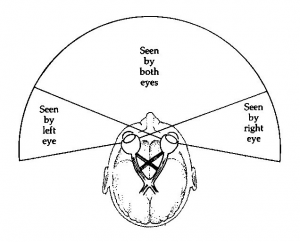
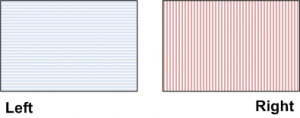
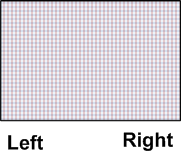
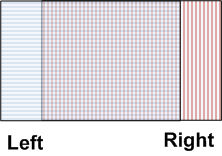
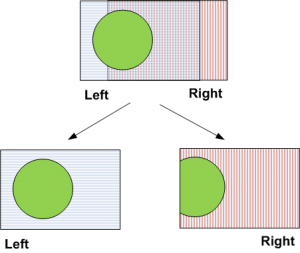
Binocular overlap is the overlapping region between the two eyes of a stereoscopic vision system. It is a term that describes the shared space that can be seen by both eyes as opposed to by just one of the eyes (Figure 1). It is different from the visual field, which is defined as the area of space seen by either eye at a single instant. In a virtual reality (VR) environment, the binocular overlap area is the region where true stereoscopy is produced. According to Mon-Williams et al. (1993), “the HMD attempts to simulate binocularly overlapped images so that the fusion of disparate images can create the illusion of a three-dimensional world.” [1] [2] [3] [4]
There are different amounts of binocular overlap required in a VR experience depending on the distance of focus. For long distances, a lesser degree of binocular overlap is necessary compared to close-up objects. In this case, a high degree of binocular overlap is needed to achieve realism. [2]
Visual field and binocular overlap
Normally, the visual field extends 60 degrees inward and 100 degrees outwards; and 60 degrees above and 75 below the horizontal meridian. It should be noted that the visual field differs from person to person. Typically, the binocular overlap area is 120 degrees horizontally, and since each eye as a visual field of about 160 degrees, the binocular overlap covers a total of 75% of that area (120/160). [5]
Binocular overlap plays an important role in depth perception. When an object is seen, each eye rotates so the object is observed in the same location in both views. The relative angles of the eyes provide an estimate of how far away the object is located. If the object being observed is far away, the angle in which it is seen by both eyes is almost the same; however, if the object is close, the angles will be different. [1] [5]
For virtual reality application, head-mounted display (HMD) manufacturers can increase the overall horizontal and diagonal field of view (FOV) of the VR headset by creating partially overlapped systems. [6]
Binocular overlap in VR HMDs
Since binocular overlap influences the field of view in a HMD, VR manufacturers have to decide how much of it to incorporate in their headsets. For example, if a VR HMD has two eyepieces with a 60-degree diagonal field of view and a 4:3 aspect ratio (Figure 2), converting that to horizontal and vertical degrees gives 48 degrees for the former and 36 degrees for the latter. If the eyepieces had 100% overlap between them, the combined binocular field of view would also be 48 degrees horizontal and 36 vertical (translating in 60 degrees diagonal). In this case, everything that can be seen by one eye can be seen by the other (Figure 3). [1]
However, if the VR HMD manufacturer decided to install eyepieces with 75% horizontal overlap (called partial overlap) the resulting binocular horizontal field of view would be 60 degrees. The overlapping region would encompass 36 degrees (75% of 48 degrees); adding to this the 12 degrees that are just shown in the left eyepiece, plus the 12 degrees only shown by the right eyepiece (Figure 4), and the 60-degree horizontal FOV is reached. Converting this number to the diagonal field of view gives a total of 70 degrees, which is larger than the diagonal field of view obtained when using 100% overlap. [1]
Indeed, a wider field of view is one of the advantages of using partial overlap. This means a greater level of immersion can be realized. Another advantage is an improved aspect ration. Following the example provided above, the original aspect ratio was 4:3. When using 75% overlap, the aspect ration became 5:3, making it more suitable for viewing widescreen content. [1]
However, partial overlap can have its disadvantages in a virtual reality headset such as binocular rivalry. If there is an object that is partially in the binocular overlap region and partially in a region exclusive to one of the eyes (Figure 5) it will be fully visible by one of the eyes and only partially by the other. If a user looks through both eyepieces at the same time, he might notice the border on the field of view of one of the eyes caused by the object's location, and this might be distracting. Instead of seeing a summation of the two images, the user’s perception will switch from one image to the other. [1]
Another disadvantage of partial overlapping is the compatibility problems with non-3D content. In a fully-overlapped system, standard content can be viewed with no noticeable problems since the same content is presented on both eyes. However, in the case of partial overlap, if the same content was present to both eyes, it would result in eye strain since the eyes would try to merge the two images even though they are shown in different angles. This means that in partial-overlap systems, the applications need to compensate for the difference between the two eyes. [1]
References
- ↑ 1.0 1.1 1.2 1.3 1.4 1.5 1.6 Boger, Y. (2016). Understanding binocular overlap and why it’s important for VR headsets. Retrieved from https://www.roadtovr.com/understanding-binocular-overlap-and-why-its-important-for-vr-headsets/
- ↑ 2.0 2.1 Virtual Worldlets. Binocular Overlap. Retrieved from http://www.virtualworldlets.net/Resources/Dictionary.php?Term=Binocular%20Overlap
- ↑ Fuchs, P. (2017). Virtual Reality Headsets - A Theoretical and Pragmatic Approach. CRC Press
- ↑ Mon-Williams, M., Wann, J.P. and Rushton, S. (1993). Binocular vision in a virtual world: visual deficits following the wearing of a head-mounted display. Ophthalmic and Physiological Optics, 13: 387-391
- ↑ 5.0 5.1 Boger, Y. (2013). What is Binocular overlap and why should you care? Retrieved from http://vrguy.blogspot.pt/2013/05/what-is-binocular-overlap-and-why.html
- ↑ Sensics. How binocular overlap impacts horizontal field of view. Retrieved from http://sensics.com/how-binocular-overlap-impacts-horizontal-field-of-view/

